CORNELL UNIVERSE
Cornell Universe
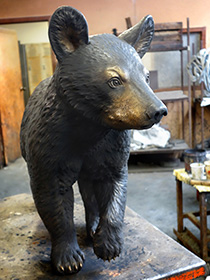
The new Touchdown statue during patina application. See larger image
A bear of a pour for new statue
The new Touchdown statue – dedicated during Homecoming Weekend at the new 1915 Plaza in front of Teagle Hall – honors the four, live black bear cubs (each named "Touchdown") who served as the university's unofficial mascot in 1915, 1916, 1919 and 1939. The plaza commemorates Cornell's first undefeated and national championship football team.
The statue, plaza, landscaping and a maintenance endowment were created through contributions by more than 300 alumni and friends, spearheaded by John Foote '74 and Joseph Thanhauser '71.
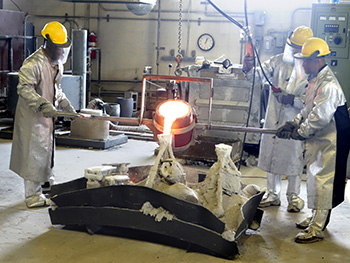
Molten bronze is poured into parts of the Touchdown statue mold in Farmingdale, New York. See larger image
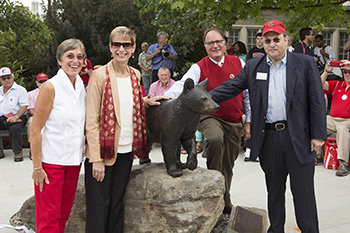
Susan Murphy, Cornell President Elizabeth Garrett, Joseph Thanhauser and others pose with the new Touchdown statue during its dedication in September. See larger image
The bronze statue was cast over the summer at Elliot Ganz and Co. in Farmingdale, New York. According to Brooklyn-based sculptor Brian Caverly, who designed the sculpture, the "lost wax" method, also known as investment casting – a thousands-of-years-old process – was used to create Touchdown.
A plasticine (oil-based clay) sculpture is created and coated with urethane rubber and a fiberglass "mother mold." Wax, poured in and out of the mold, is built up into a 3/16"-thick layer that is removed from the mold and dipped, in multiple pieces, into a liquid slurry. The pieces are baked in an oven and harden into a ceramic shell as the wax melts out, leaving hollow space in the form of the original sculpture.
The ceramic shells are buried in sand, into which molten bronze (heated to more than 2,000 degrees Fahrenheit in an induction furnace) is poured. About 150 pounds of bronze was poured to create the Touchdown sculpture, Caverly says.
After cooling overnight, the ceramic shell is removed from the bronze pieces; the statue is assembled and the pieces welded together, with the welds resculpted to match the surface of the sculpture. The final step is coloring and applying the patina to the finished sculpture using various chemicals and heat.
In fashion, origami turns function into form
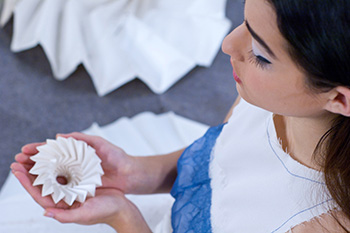
Origami forms that were part of the design for Lea Freni's 'Fibonacci skirt.' See larger image
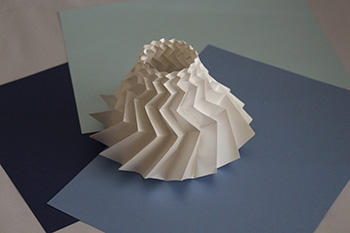
Origami forms that were part of the design for Lea Freni's 'Fibonacci skirt.' See larger image

Lea Freni. See larger image
A skirt with zigzagging, billowing crease lines that appeared on the runway of an international fashion show hides Cornell science in its folds.
Part of a Cornell alumna's clothing line that debuted at Vancouver Fashion Week, Sept. 28-Oct. 4, the skirt's design was directly inspired by Cornell physics research on using origami to tailor the mechanical properties of materials.
The "Fibonacci skirt" is part of the spring/summer collection of VOGEL, a brand launched by Lea Freni '15, a graduate of the Department of Fiber Science & Apparel Design in the College of Human Ecology.
A designer drawn to mathematical elements and clean lines, Freni teamed with Uyen Nguyen, a research associate in the lab of Cornell physics professor Itai Cohen, on a project to factor origami principles into fashion design. She and Nguyen worked together on the skirt and are collaborating on other designs for VOGEL.
The designers based the skirt's folding pattern on the Fibonacci sequence, a famous, self-similar number series.
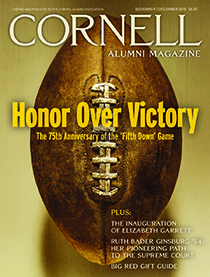
Cover of Cornell Alumni Magazine's November/December 2015 issue. See larger image
Recommended read: Cornell Alumni Magazine
Since 1899, Cornell Alumni Magazine has been an independent source of news and views on your alma mater and has celebrated the achievements of Cornellians near and far. The upcoming issue recalls the "Fifth Down" game of 1940, when Cornell chose ethics over gridiron glory; excerpts a new book by a Cornellian legal scholar chronicling Ruth Bader Ginsburg's path to the Supreme Court; and offers holiday shopping ideas with a Big Red gift guide. The magazine also brings news of your classmates in the Class Notes.
To subscribe, go to cornellalumnimagazine.com/subscribe. For a complimentary sample copy, e-mail Editor Jenny Barnett at jbarnett@cornell.edu, or write to Cornell Alumni Magazine, 401 E. State St., Suite 301, Ithaca, NY 14850. The editors also welcome your comments and story ideas.
Social media's dazzling windows on Cornell

Sunset photo by Pam Divack. See larger image
Keep up with Cornell's campuses, people and happenings (plus links and other info) on Cornell's social media channels – Facebook, Instagram, Tumblr, Twitter and more; they are digital windows into the life of the university right now.
Check out, follow or subscribe to Cornell at www.facebook.com/Cornell, www.instagram.com/cornelluniversity, cornelluniversity.tumblr.com and www.twitter.com/Cornell.